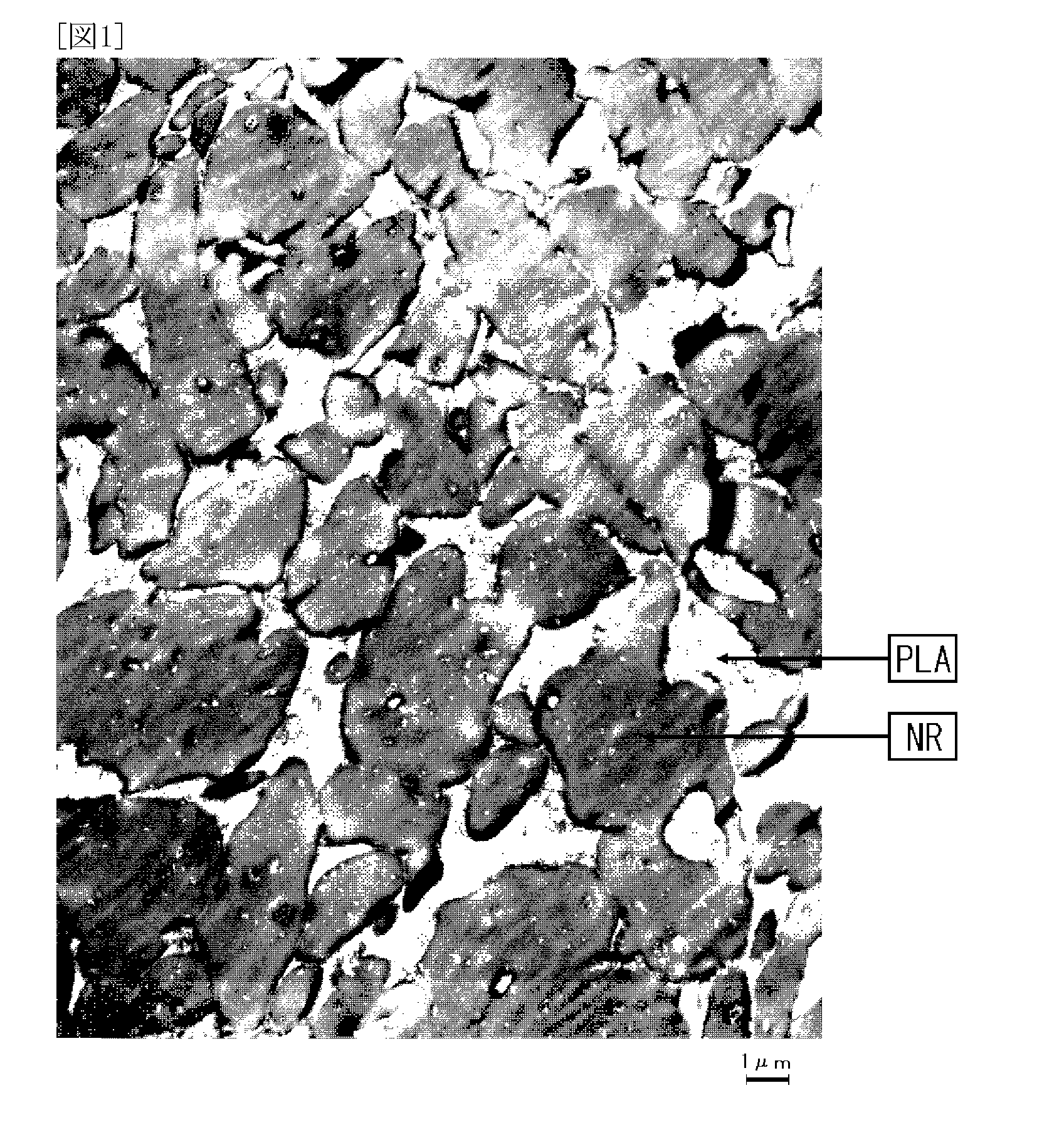Thermoplastic elastomer composition
a technology of elastomer and composition, applied in the direction of organic dyes, etc., can solve the problems of environmental pollution caused by plastic waste, global warming due to gasses generated, plastics are inferior in flexibility, rubber elasticity, compression set properties, etc., to achieve superior flexibility, compression set properties and formability, and less burden on the environment
- Summary
- Abstract
- Description
- Claims
- Application Information
AI Technical Summary
Benefits of technology
Problems solved by technology
Method used
Image
Examples
example 1
[0100]PLA; LACEA H-100 (manufactured by Mitsui Chemicals, Inc.) and EPDM; EP22 (manufactured by JSR Corporation), and Bondfast 7M (manufactured by Sumitomo Chemical Co., Ltd.) that is a copolymer of ethylene, glycidyl methacrylate and methyl acrylate as a compatibility accelerator were melted and kneaded at a ratio (parts by weight) shown in Table 1 using Laboplastmill 50C150 (blade shape: roller type R60 manufactured by Toyo Seiki Seisaku-sho, Ltd.) which had been preset at 180° C. Furthermore, EDMA as a crosslinking activator, and Perhexine 25B (manufactured by NOF Corporation) that is a peroxide as a crosslinking catalyst were added to the mixture at a ratio (parts by weight) shown in Table 1, while melting and kneading with a screw rotation frequency of 100 rpm at 180° C. The melting and kneading was carried out until the torque value exhibited the maximum level, and thereafter declined to reach a constant level, whereby the crosslinking reaction was allowed to proceed (dynamic ...
example 2
[0101]PLA; LACEA H-100 (manufactured by Mitsui Chemicals, Inc.) and EPDM; EP22 (manufactured by JSR Corporation), and Bondfast 7M were melted and kneaded at a ratio (parts by weight) shown in Table 1 using Laboplastmill 50C150 (blade shape: roller type R60 manufactured by TOYO SEIKI Co., Ltd.) which had been preset at 180° C. Furthermore, EDMA as a crosslinking activator, and Perhexine 25B (manufactured by NOF Corporation) that is a peroxide as a crosslinking catalyst were added to the mixture at a ratio (parts by weight) shown in Table 1, while melting and kneading with a screw rotation frequency of 100 rpm at 180° C. The melting and kneading was carried out until the torque value exhibited the maximum level, and thereafter declined to reach a constant level, whereby the crosslinking reaction was allowed to proceed (dynamic crosslinking). Furthermore, after the torque reached a constant value, Lactcizer GP-4001 (manufactured by Arakawa Chemical Industries, Ltd.) that is a plasticiz...
example 3
[0102]A sample was produced in a similar manner to Example 1 except that NR; RSS3 was used in place of EPDM, and that the amount of added Perhexine 25B (manufactured by NOF Corporation) was changed. Thus, evaluation was carried out.
PUM
| Property | Measurement | Unit |
|---|---|---|
| particle size | aaaaa | aaaaa |
| particle size | aaaaa | aaaaa |
| temperature | aaaaa | aaaaa |
Abstract
Description
Claims
Application Information
 Login to View More
Login to View More - R&D
- Intellectual Property
- Life Sciences
- Materials
- Tech Scout
- Unparalleled Data Quality
- Higher Quality Content
- 60% Fewer Hallucinations
Browse by: Latest US Patents, China's latest patents, Technical Efficacy Thesaurus, Application Domain, Technology Topic, Popular Technical Reports.
© 2025 PatSnap. All rights reserved.Legal|Privacy policy|Modern Slavery Act Transparency Statement|Sitemap|About US| Contact US: help@patsnap.com

